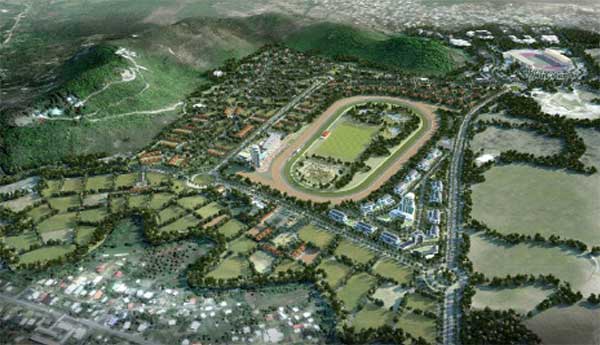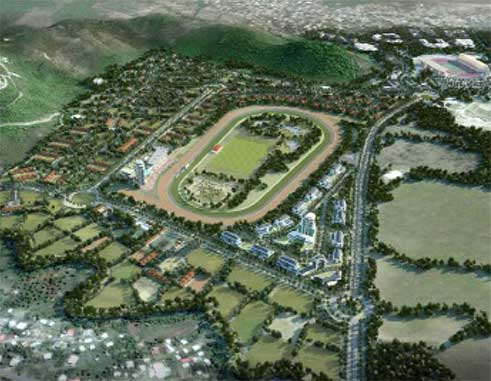THE St. Lucia government this week released a “ Pearl of the Caribbean Fact Sheet” which answers some of the questions that are being raised about the multi million dollar Desert Star Holdings investment project planned for Vieux Fort.

The document, in a Question and Answer format follows:
● What is a Framework Agreement?
A framework agreement is a general phrase for agreements between two parties that recognizes that the parties have not come to a final agreement on all matters relevant to the relationship between them,but have come to agreement on enough matters to move forward with the relationship, with further details to be agreed to in the future. The Government of Saint Lucia signed a Framework Agreement with Desert Star Holdings Limited for the Pearl of the Caribbean project at Vieux Fort in July 2016.
● Who is Desert Star Holdings Limited?
Desert Star Holdings Limited is a management and investment company. This Hong Kong-based company has developed the thoroughbred industry in Hong Kong, through sound physical planning expertise and strategic development approaches. Formed in 2012, the company has at its core, equine management. Desert Star’s expertise stems from the work experiences of its principal Teo Ah Khing in equine facilities design and development. Desert Star has made their presence felt in the global equine affairs with its landmark project – Tianjin Equine Culture City (TECC) – in China.
● What is the proposed project plan between the Government and DSH?
The Saint Lucia Government has entered into a partnership with Desert Star Holdings Limited for the development of the Pearl of the Caribbean, a development plan for the south of the island. The proposed project will comprise a marina, a racecourse, a resort, shopping mall complex, casino, Free Trade Zone, entertainment and leisure facilities, eco-tourism as well as architecturally designed villas and apartments. It is expected that the project will raise economic activity in the south of the island and provide significant job opportunities.
● What is the current status of the joint venture Pearl of the Caribbean?
The Pearl of the Caribbean is still in the planning stages. Facilitated by Invest Saint Lucia, the Government is in the process of developing with DSH, the Master Plan for the area. The race track comprising the first phase of the project is currently being pursued. The racetrack will be located on approximately 200 acres of land at Beausejour and the plans have been submitted to the Development Control Authority (DCA) and have been approved in principle pending an Environmental Impact Assessment (EIA).
BEACHES
● Will there be public access to all beaches within the Pearl of the Caribbean location?
Yes. Saint Lucia’s beaches are by law all public access and this will not change with the Pearl of the Caribbean. In fact, there will be recreational areas and beach facilities which include restrooms for public use. There is no threat to beach access for anyone. The developer has made provisions for locals in their plans for the development of Anse de Sable. Neither beaches are in jeopardy of being “taken away from the people”. In fact, the new facilities and upkeep of the beach will make it even more inviting for all.
● Will Government Sell Land at US $1 an acre?
No. As part of its investment in the Pearl of the Caribbean the government is proposing to lease lands to DSH at US $1 an acre which do not form part of the project’s private commercial parameters. This is part of our contribution to this joint project. The aim of the Government is to get this project going to facilitate benefits to Saint Lucia that would far exceed what it would make from leasing this land at a larger amount. Moreover, it is commercially customary for discounts to be given to an investor based on the scale of the proposed project. It would have proven prohibitive to demand from the investor the full commercial value for an unproductive portion of land, which could have been detrimental to the viability of the project.
● Will 840 acres of land be given away to one developer?
No. The Government is not “giving away” land to the developer. The purchase price per acre of land will be between US $60,000 to US $90,000. Further, lands will only be transferred to the developer according to the developer’s phasing schedule and in any event, only when the developer is in a position to proceed with that particular phase of the project. At present, 840 acres have not been transferred to the developer, but the Government of Saint Lucia, through ISL, is in the process of transferring only that portion of land to the developer which is required for the commencement of phase 1 of the project.
● What will happen to Mankote Mangroves?
The Mankote Mangrove does not form part of the project.
● Are livestock and pig farmers going to be dislocated and what is being put in place to protect their businesses?
Livestock farmers in the Beausejour area have already been engaged with regard to the first phase of the project. Pending planning approval of the project, farmers will be further engaged and relocated in a manner which does not place them at a disadvantage.
● What will become of the VF landfill?
The Vieux Fort Landfill is not currently part of the Pearl of the Caribbean project. However, there have been plans to decommission the landfill for years as it poses serious environmental risks to the area, including the Mankote Mangrove. As a result, the Government is reviewing a study that had previously been commissioned on this matter. The Pearl of the Caribbean project has simply given the Government the required impetus to address this long outstanding issue of waste management in Saint Lucia.
● Will the George Odlum stadium be demolished as part of the DSH Project?
The Government has invited the Master Planner to propose a plan for what can be done with the George Odlum stadium, which is already in a deplorable state following years of neglect, within a broader context of enhancing the educational offerings in Saint Lucia. To renovate the stadium once the Saint Jude’s Hospital is relocated would cost the Saint Lucia Government millions of dollars.
● How many Saint Lucians will be employed in the Construction Phase of the racetrack and beyond?
No Government can give a figure as to how many persons will be employed in any project whether it be foreign or domestic. That would wrongly place an unfair and uncommercial burden on an investor. It is expected however, that all able-bodied, capable local workers will be engaged during the construction phase, although there may be a need to engage foreign specialists with the expertise for a project of this nature. The Government of Saint Lucia is primarily concerned with permanent job placements and not the transient kind, albeit just as important.
● Will Saint Lucians receive training in Equine Industry?
The Government will make a commitment to the development of the Equine Industry in Saint Lucia. This is new territory for Saint Lucia and the Government will establish an Education Training Fund in partnership with DSH. It is anticipated that many opportunities will be created for Saint Lucians to participate within the equine industry and the project (hotel, casino, marina etc) as a whole.
What will happen to the current Abattoir in the proposed lands?
Pending the Development Control Authority’s (DCA’s) approval of theproject, the abattoir will be relocated at the cost of the developer.
● Is the Saint Lucia Government taking all the risk on the DSH Project?
No. This is a joint project and both parties involved in this project are making significant contributions. Saint Lucia’s proposed contribution includes the leasing of state lands, proceeds from approved CIP investors, and standard tax exemptions for a definite timeframe.
The Developer has undertaken to construct the track out of their own funds, and shall also be rebuilding the abattoir at their costs. The Developer also has considerable reputational risk invested in the project.
● Are there environmental safeguards?
Yes. The Saint Lucia Government will ensure that the developer who has an excellent track record when it comes to the environment, takes the necessary steps to preserve the environment, including the submission of an Environmental Impact Assessment.
INVESTMENT
● Will the developer get all the profits?
Like any commercial undertaking, a private party will always seek an adequate return on investment. A government however is primarily concerned with job creation, economic activity and applying its idle resources/assets towards productive uses. This project proposes to address all those concerns. Like the developer, the Government will only profit (economically) on the success of the project.
● Is DSH getting an exclusive deal that would restrict future investments?
Given the scale of the project and the fact that the project is the first fully integrated tourism enterprise project in Saint Lucia, the investor required a period of time during which the project would be allowed the latitude to become successful. Exclusivity however relates solely to an investment which is a “fully-integrated” development and not to an ordinary non-fully integrated development.
● What are the fail safes for Saint Lucia if the project has challenges?
Saint Lucia has the option to purchase our lands back from the developer at the same price it was sold if the Developer does not raise the required development capital. The “buy-back” clause in the Framework Agreement ensures that Saint Lucia will always retain ownership of the land. The sales agreement will govern the precise terms of the purchase including any ‘buy-back’ provision.















Re the DSH project this latest info has thrown a lot of light ? This is the sort of info the people need. However, I have a couple more concerns;
1. Is DCA giving the developer special exceptions relative to established procedures in submitting plans for approval?
2. All types of work can be beneficial to our local workforce–transient and permanent.
3. My recent concern and fears about leasing land at $1US per acre has now been allayed somewhat now that the “buyback” clause is clear. However the 99years still bugs me.
I DID NOT GET THE INFORMATION THAT I WANTED……………
was this land previously used for agriculture?